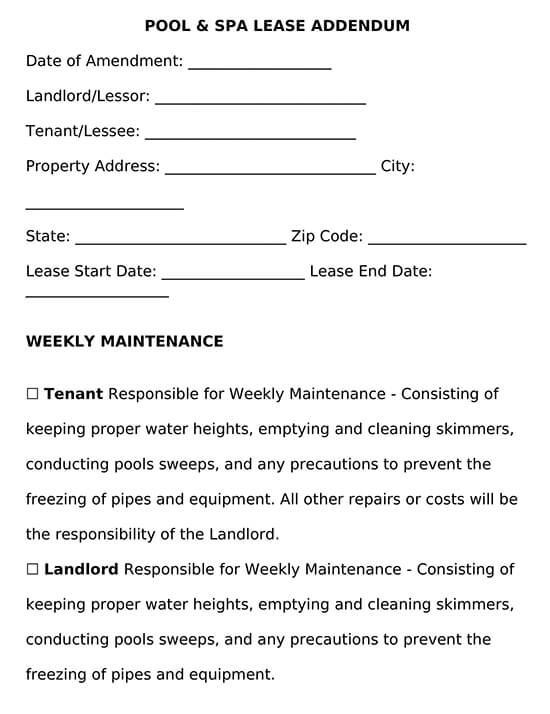This addendum serves as both a document laying out the rules and use of the pool/spa and as protection for the landlord should an injury occur or damage be done by the tenant when using it. It’s an additional document that is attached to your main lease agreement, and it details the rules regarding using the facilities.
You can use this addendum for both shared and private pools/jacuzzis/hot tubs and outlines whether the landlord or tenant will have the responsibilities of upkeep and maintenance of them and any equipment. The addendum also states that the landlord will not be held liable for any negligence or injuries related to using the pool/spa by a tenant or guests.
Free Template

Why a Pool and Spa Lease Addendum is Needed
The use of a pool or spa in a rental property does have some risks, which is why having an addendum specific to its use is important. It will ensure that a tenant can be held accountable for any damages or injuries caused by not adhering to the contract.
It serves a few purposes:
- It outlines the usage rules
- It details financial liabilities
- It outlines the designated person who is responsible for the pool or spa
- It lowers your risk and liability
How to Create this Lease Addendum
While the regulations may differ from one landlord to the next, there are some main things that this addendum should have on it.
Identifying Information
At the beginning of the addendum, you should have identified information to ensure there is no confusion regarding the people signing the addendum and the property it is for.
It should have:
- Date
- Address of the rental property
- Name of the landlord
- Name of the tenant
- Start and end date of the lease
Introduction
An introductory statement should come next. It should state the purpose of the document and say something similar to this:
EXAMPLE
“The pool or spa addendum is set out to disclose the rules of the equipment located at the property listed above. Access to the pool/spa is open to all tenants, providing they acknowledge and follow the rules outlined below at all times.”
Rules that should be listed:
- Use at your own risk – this clarifies that usage of the pool/spa is at the risk of the tenant and is important to protect you from liability.
- Age restrictions – this details any age restrictions, such as children under a certain age needing to be supervised for their own safety.
- Cautions – this is used to remind your tenants that it is up to them to be safe and careful when they are using the pool/spa because it can be dangerous. You should also state that you, as the landlord, are not responsible for any injuries that occur when using the pool/spa.
- Limitations – if there are periods when the pool cannot be used, either due to cold temperatures, severe weather, or for maintenance, you should outline those details here.
- Responsibilities – in this section, you need to clarify who is responsible for maintaining the pool, whether it is financially or for upkeep. If the pool is in a multiple residential building, this responsibility will fall upon the landlord.
- Damage – in this section, you will remind the tenants that they will be financially responsible for any damage done to the pool/spa and its equipment.
- Privileges – in this section, you need to make it clear that you can revoke the privileges of pool/spa use if the tenant does not adhere to the rules.
Additional Rules to Consider
To ensure the pool/spa is being used in the right way, you may want to include some additional rules based on your state and local laws.
EXAMPLE
Some states require that a pool be fenced in
This means you should add a rule stating that it is the tenant’s responsibility to make sure the pool/spa gates of properly closed and locked up at all times.
You may also want to add a rule regarding guests using the pool. If it’s a pool being used by several tenants, you may need to limit how many guests they are allowed to have in the pool to be fair to other tenants. Or, you may choose to not allow any guests.
If there are security procedures required to enter and exit the pool area, be sure to add this to the addendum as well. This makes the tenants accountable should theft or damage be done as a result of them not following the security protocol you have outlined.
Pros and Cons of a Property with a Pool or Spa
While maintaining a pool or spa in a rental property can be a big task, it does have some benefits, especially with a multi-unit property. They can be a big attraction that allows you to charge more for the use of this amenity. It can make it easier to find tenants. Your overall property value also rises when you have a pool or spa, and you can add the costs of maintenance to the rent.
There are also some downsides to consider with having such facilities. It can be a liability involving several factors:
- Safety
- Security
- Upkeep
- Cleaning
- Repairing fixtures
If your tenants are going to be responsible for the cleaning and upkeep, you will need to make sure that:
- They understand how to clean the pool or spa
- They know how often you will need access to make sure it is being maintained properly
- They need to know what will happen should the equipment become damaged
Frequently Asked Questions
Yes, it is legally binding if both parties have agreed and signed the contract.
If you find you need to make changes to a lease, it will mean that a new agreement must be written up and signed by both parties.
Yes, they can, but they do need the consent of the tenant. This is done by the landlord, making an addendum to the lease to present to the tenant. Changes in rules are only legally binding if both parties agree and sign it.
An amendment refers to making changes to a document that already exists. An addendum refers to adding a document to one that already exists..












